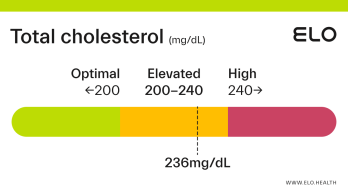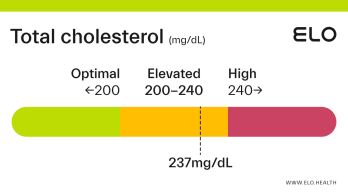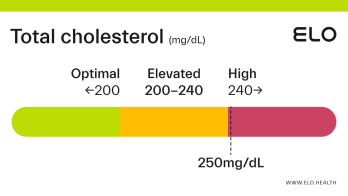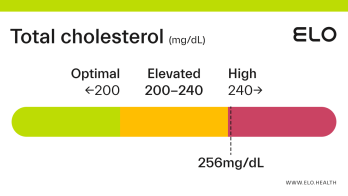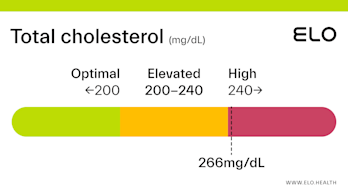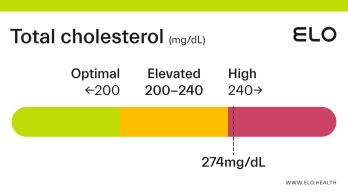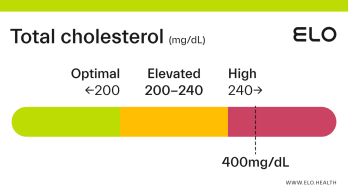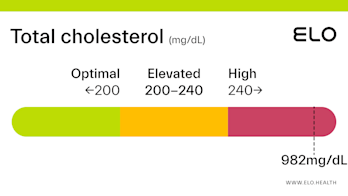Total Cholesterol: 275 mg/dL
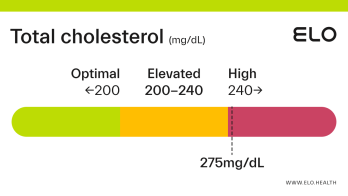
What does a total cholesterol level of 275 mean? Are there any symptoms associated with this level?
A total cholesterol level of 275 mg/dL is considered high. Although cholesterol has several essential functions in the body, high cholesterol puts you at greater risk for heart disease.
Your total cholesterol is calculated by adding your LDL (bad) cholesterol, HDL (good) cholesterol, and 20% of triglyceride levels.
LDL is often referred to as “bad” cholesterol because it accumulates in your blood vessels and increases your risk for heart disease. Ideally, LDL levels should be less than 100 mg/dL, but lower is better.
HDL is considered “good” cholesterol because it scavenges “bad” blood cholesterol and returns it to the liver for excretion. A HDL level >60 mg/dL is considered optimal and can be protective against heart disease, though levels >40 mg/dL for men and >50 mg/dL for women are still considered good.
Triglycerides are another type of fat that builds up in the bloodstream and increases your risk of heart disease. Ideally, triglycerides should be <150 mg/dL.
While high cholesterol is commonly linked to diet and lifestyle factors, familial hypercholesterolemia (FH) can also cause high cholesterol levels. FH is a common genetic disorder that causes high levels of LDL cholesterol. If untreated, FH leads to early heart attacks and heart disease, even in young adults and children. Because FH is inherited, when someone in your family is diagnosed, it’s important all family members are also screened for this condition.
High cholesterol doesn’t have symptoms, so it is important to know your levels. Lowering your cholesterol will lower your risk of developing heart disease and other health issues. If you already have heart disease, lowering your cholesterol can reduce your odds of serious complications, like a heart attack or stroke.
Factors that could contribute to a total cholesterol level of 275:
Diet: Diets both low in fiber and high in saturated fats, trans fats, and added sugar can increase blood cholesterol.
Weight. Being overweight also tends to increase cholesterol levels.
Physical Activity. Being active can help lower LDL (bad) cholesterol and raise HDL (good) cholesterol levels.
Smoking: Smoking lowers your HDL (good) cholesterol, which can contribute to a higher level of bad cholesterol.
Medications: Some medications can increase cholesterol levels, including corticosteroids, beta-blockers, thiazide diuretics, antivirals, retinoids, and growth hormones.
Diseases: Some diseases may elevate total cholesterol, including chronic kidney disease, diabetes, and HIV/AIDS.
Age and Sex: Premenopausal women tend to have lower total cholesterol levels than men of the same age. However, cholesterol levels tend to increase with age in both women and men. After the age of menopause, women's LDL (bad) cholesterol levels tend to rise.
Genetics (heredity): Genes partly determine how much cholesterol your body makes; therefore, high blood cholesterol can run in families.
Race: Certain races may have an increased risk of high blood cholesterol. For example, Blacks/African Americans typically have higher HDL and LDL cholesterol levels than Caucasians.
Elevated HDL (good) cholesterol: A HDL level above 70 mg/dL may contribute to high total cholesterol. High HDL is considered protective against heart disease; however, LDL and triglyceride levels should be in the healthy range.
What to do if your total cholesterol level is 275?
Making changes to your diet and adopting healthier habits can lower your total cholesterol level. Here are a few things you can do to reduce your cholesterol:
Fill up on fiber-rich foods, including veggies, fruit, whole grains, and legumes. Gradually increase your fiber intake to 30-40 grams of fiber per day.
Limit refined carbs and added sugars such as soda, chips, candy, baked goods, sweetened yogurt, and ice cream.
Avoid trans fats (partially hydrogenated oils) and reduce your saturated fat intake to < 10% total calories.
Eat small, fatty fish, including salmon, sardines, and trout, at least twice a week.
Be active every day. Try to get 30-60 minutes of physical activity most days of the week.
Get 2 grams of plant sterols and stanols daily, in the form of food or a supplement.
Lose weight if you are overweight or obese.
Quit smoking if you currently smoke.
If you have diabetes, achieve and maintain good blood sugar control (HbA1c).
Medications and supplements used to improve total cholesterol results
If diet and lifestyle changes are not enough to lower your cholesterol, some medications and supplements can be helpful to get them into a safer range. Some common ones include:
Medications
Medications can help if diet and lifestyle changes do not lower total cholesterol levels enough on their own. Some common cholesterol medications include:
Statins: Statins (including atorvastatin, simvastatin, and rosuvastatin) reduce cholesterol production in your liver. Because they typically need to be taken for life, statins are only prescribed if diet and lifestyle changes aren’t enough [3].
Ezetimibe can be helpful for those with familial hypercholesterolemia and who have side effects with statins.
Bile acid sequestrants: These medications block cholesterol-rich bile acid from being absorbed into the bloodstream and can be taken in place of or in addition to a statin.
PCSK9 inhibitors: This medicine is prescribed alongside a statin if you are at high risk of heart attack or stroke, or have familial hypercholesterolemia. It is typically injected under your skin every 2 or 4 weeks.
Lomitapide: Typically prescribed if you have familial hypercholesterolemia and requires liver enzyme monitoring as it can cause liver damage. Lomitapide is commonly also taken with vitamin E.
Supplements
Plant sterols and stanols: Plant sterols and stanols (also called phytosterols) are found in plant cell membranes and are similar in structure to cholesterol in the body. When consumed, phytosterols block dietary cholesterol from being absorbed. They are found in small quantities in vegetable oils, nuts, legumes, whole grains, fruits, and vegetables; however, the average daily intake (500 mg) is typically not enough to lower cholesterol. Studies show that consuming 2000 mg (2g) of plant sterol and stanols daily from diet and supplements lowers total cholesterol [4]. Plant sterol and stanol supplements taken before or with meals can help lower total cholesterol in parallel with other recommended diet and lifestyle changes [4].
Omega-3 (EPA & DHA): Omega-3 fatty acids (specifically EPA & DHA) can significantly reduce blood triglyceride levels. For cholesterol-lowering benefits, aim to consume 2,400-3,000 mg of omega-3 fats per day from your diet (salmon, mackerel, and trout are all good sources) and a quality fish oil supplement.
Beta-glucan: Beta-glucan is a form of soluble fiber that has been shown to help lower cholesterol levels. It’s found naturally in whole grains like barley, oats, rye, wheat, mushrooms, and seaweed. It is also available as a nutritional supplement. For cholesterol-lowering benefits, consume 3-7 g/day from your diet and a supplement.
Psyllium: Another type of soluble fiber made from the husk of psyllium seeds, psyllium is good for digestive health and regularity and can also help lower cholesterol. Psyllium supplements are sold in powder form and can help reduce lipid levels when taken daily at a dose of 8-12 g/day.
Alpha-lipoic acid: Alpha-lipoic acid is a potent antioxidant. It is made in the body and occurs naturally in foods like carrots, beets, spinach, broccoli, potatoes, and red meat. Research suggests that 600 mg/day of alpha-lipoic acid from your diet and a supplement may help lower total cholesterol and LDL (bad) cholesterol [8].
Turmeric: A spice commonly used to flavor and color curry dishes, turmeric may help lower pro-inflammatory markers, blood cholesterol, and triglycerides [9]. More research is needed to determine optimal form and dosage but supplementing with 500 mg/day appears safe and potentially beneficial for lowering cholesterol.
Bergamot extract: Taking bergamot extract (made from the juice of the bergamot fruit) may help lower cholesterol and triglyceride levels in adults with high cholesterol [10,11]. One study suggests taking bergamot extract daily for a month may be as effective as taking a low dose of the cholesterol-lowering drug called rosuvastatin (Crestor) [11]. A recent research review indicates that 1000 mg/day may be most effective for lowering cholesterol.
Green tea extract: Green tea extract is a natural supplement that can help lower LDL (bad) and total cholesterol [12]. A daily dose of 400 mg may help lower your cholesterol but check with your doctor first as green tea extract can interact with certain medications, including beta-blockers and blood thinners. In addition, green tea extract may also have a stimulant effect.
References
Cholesterol Levels: What You Need to Know. (n.d.). U.S. National Library of Medicine | NIH. Retrieved September 9, 2021, from
https://medlineplus.gov/cholesterollevelswhatyouneedtoknow.html
Carotid Artery Disease. (n.d.). National Heart, Lung, and Blood Institute | NIH. Retrieved September 9, 2021, from
https://www.nhlbi.nih.gov/health-topics/carotid-artery-disease
High cholesterol. (n.d.). NHS Inform. Retrieved September 9, 2021, from
https://www.nhsinform.scot/illnesses-and-conditions/blood-and-lymph/high-cholesterol
Racette, S. B., Lin, X., Lefevre, M., Spearie, C. A., Most, M. M., Ma, L., & Ostlund, R. E., Jr (2010). Dose effects of dietary phytosterols on cholesterol metabolism: a controlled feeding study. The American journal of clinical nutrition, 91(1), 32–38.
https://doi.org/10.3945/ajcn.2009.28070
Cholesterol: Types, Tests, Treatments, Prevention. (2020, July 31). Cleveland Clinic.
https://my.clevelandclinic.org/health/articles/11920-cholesterol-numbers-what-do-they-mean
Lower Your High Cholesterol. (2000, January 1). WebMD.
https://www.webmd.com/cholesterol-management/guide/lower-cholesterol-risk
Omega-3 fatty acids fact sheet for health professionals. Office of Dietary Supplements. Retrieved October 12, 2021, from
https://ods.od.nih.gov/factsheets/Omega3FattyAcids-HealthProfessional/
Mousavi, S. M., Shab-Bidar, S., Kord-Varkaneh, H., Khorshidi, M., & Djafarian, K. (2019). Effect of alpha-lipoic acid supplementation on lipid profile: A systematic review and meta-analysis of controlled clinical trials. Nutrition (Burbank, Los Angeles County, Calif.), 59, 121–130.
https://doi.org/10.1016/j.nut.2018.08.004
Qin, S., Huang, L., Gong, J., Shen, S., Huang, J., Ren, H., & Hu, H. (2017). Efficacy and safety of turmeric and curcumin in lowering blood lipid levels in patients with cardiovascular risk factors: a meta-analysis of randomized controlled trials. Nutrition journal, 16(1), 68.
https://doi.org/10.1186/s12937-017-0293-y
Cai, Y., Xing, G., Shen, T., Zhang, S., Rao, J., & Shi, R. (2017). Effects of 12-week supplementation of Citrus bergamia extracts-based formulation CitriCholess on cholesterol and body weight in older adults with dyslipidemia: a randomized, double-blind, placebo-controlled trial. Lipids in health and disease, 16(1), 251.
https://doi.org/10.1186/s12944-017-0640-1
Gliozzi, M., Walker, R., Muscoli, S., Vitale, C., Gratteri, S., Carresi, C., Musolino, V., Russo, V., Janda, E., Ragusa, S., Aloe, A., Palma, E., Muscoli, C., Romeo, F., & Mollace, V. (2013). Bergamot polyphenolic fraction enhances rosuvastatin-induced effect on LDL-cholesterol, LOX-1 expression and protein kinase B phosphorylation in patients with hyperlipidemia. International journal of cardiology, 170(2), 140–145.
https://doi.org/10.1016/j.ijcard.2013.08.125
Xu, R., Yang, K., Li, S. et al. Effect of green tea consumption on blood lipids: a systematic review and meta-analysis of randomized controlled trials. Nutr J 19, 48 (2020).
https://doi.org/10.1186/s12937-020-00557-5

